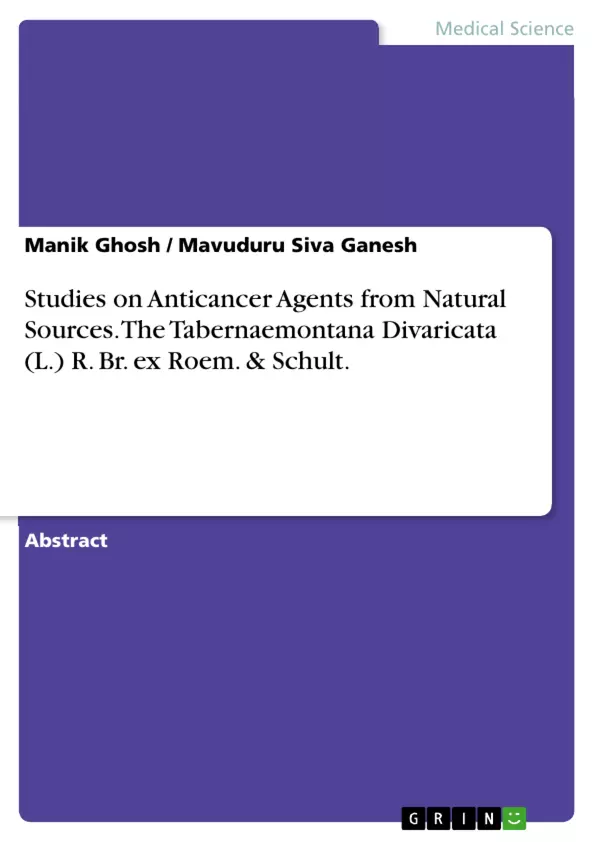Herbal medicines are in great demand over the world for primary health care because of their efficacy, safety and lesser side effects. Traditional use of medicines is recognized as a way to potential future medicines. Of the top 34 top marketed drugs for different diseases, 14 are natural compounds and natural products are main sources of anticancer agents. There are several higher plant species that need to be explored as a source of anticancer agents.
The recent great advances in medical treatment and scientific technology include many anticancer agents. The search for new anticancer agents focuses on not only synthetic compounds, but also natural products. This thesis is an approach to identify new lead molecules from the natural sources against breast cancer. Guided by the folklore knowledge, Tabernaemontana divaricata was chosen as the plant for study.
This plant is explored as per literature, and studied with regard to its phytochemical and pharmacological activities. The work has been focused towards isolation and characterization of the phytoconstituents from the leaves of the plant, which can show potent inhibitory activity against proliferation of breast cancer, and also act as novel lead molecule for development of potent anticancer drug/agent.
Inhaltsverzeichnis (Table of Contents)
- INTRODUCTION
- LITERATURE REVIEW
- OBJECTIVES AND PLAN OF WORK
- DOCKING STUDIES
- PHYTOCHEMICAL STUDIES
- PHARMACOLOGICAL STUDIES
- EXPERIMENTAL WORK
- SUMMARY AND CONCLUSION
- REFERENCES
Zielsetzung und Themenschwerpunkte (Objectives and Key Themes)
This research delves into the potential of natural sources as a source of anticancer agents, with a specific focus on Tabernaemontana divaricata (L.) R. Br. ex Roem. & Schult. The study aims to explore the anticancer properties of this plant through various methods, including docking studies, phytochemical analysis, and pharmacological investigations. The research seeks to identify potential active compounds and elucidate their mechanisms of action against cancer cells.
- Anticancer potential of natural products
- Phytochemical analysis and isolation of bioactive compounds
- Molecular docking studies to predict drug-target interactions
- Pharmacological evaluation of anticancer activity
- Exploring the therapeutic potential of Tabernaemontana divaricata
Zusammenfassung der Kapitel (Chapter Summaries)
- INTRODUCTION: This chapter provides a general overview of cancer, including its definition, prevalence, and various types. It explores the causes of cancer, highlighting the role of gene mutations, radiation, chemical irritants, hereditary factors, and viruses.
- LITERATURE REVIEW: This chapter delves into existing literature on anticancer agents derived from natural sources, focusing on research related to Tabernaemontana divaricata. It examines previous studies on the plant's phytochemistry, pharmacological properties, and potential anticancer activity.
- OBJECTIVES AND PLAN OF WORK: This chapter outlines the specific objectives and research methodology employed in the study. It details the planned docking studies, phytochemical analysis, and pharmacological investigations to be conducted on Tabernaemontana divaricata.
- EXPERIMENTAL WORK: This chapter presents the detailed experimental procedures and findings of the research, covering the docking studies, phytochemical analysis, and pharmacological evaluations. It provides a comprehensive account of the methods used and the results obtained.
Schlüsselwörter (Keywords)
The research focuses on the potential of Tabernaemontana divaricata as a source of anticancer agents. Key areas of exploration include phytochemical analysis, molecular docking studies, pharmacological evaluation, and the identification of potential bioactive compounds. The research utilizes techniques like HPLC, GC-MS, and in vitro assays to investigate the plant's anticancer activity. The study aims to contribute to the development of novel and natural-based anticancer therapies.
- Quote paper
- Dr. Manik Ghosh (Author), Mavuduru Siva Ganesh (Author), 2014, Studies on Anticancer Agents from Natural Sources. The Tabernaemontana Divaricata (L.) R. Br. ex Roem. & Schult., Munich, GRIN Verlag, https://www.grin.com/document/303968



